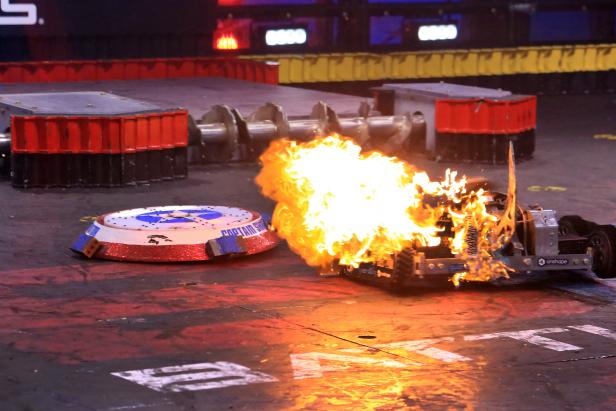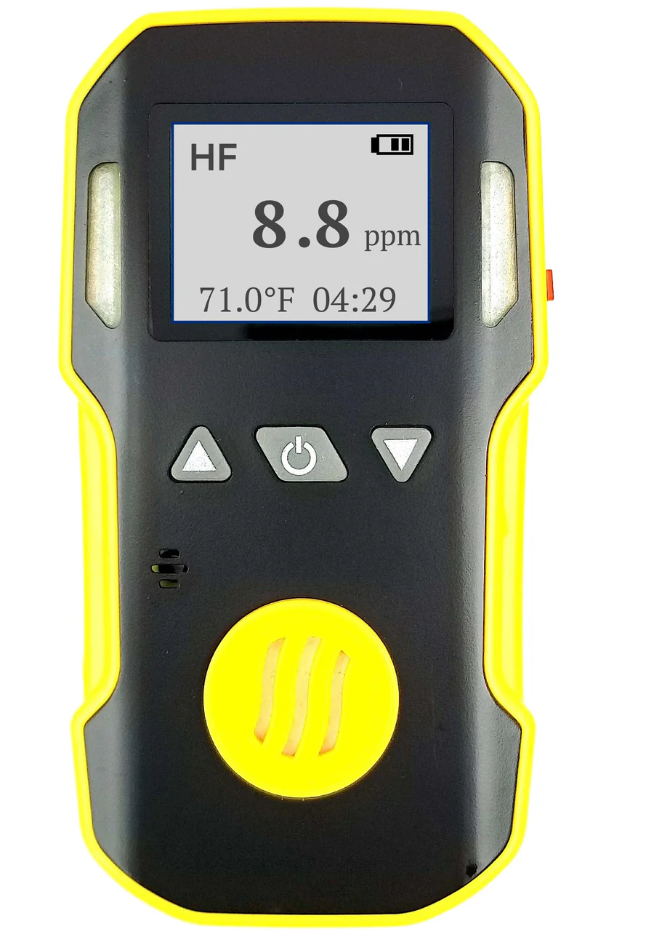Hydrogen fluoride gas detectors are crucial for protecting workers in industries that utilize this hazardous gas, as these devices continuously monitor the atmosphere and alert personnel when HF levels exceed safe thresholds. Hydrogen fluoride (HF) gas, a toxic and corrosive substance, necessitates the use of gas detectors to ensure the safety of workers directly exposed to it. HF gas is not only used in various industrial settings for manufacturing purposes, such as in the production of refrigerants, herbicides, pharmaceuticals, aluminum, and material processing, but it is also emitted when lithium batteries catch fire. Although more people may be familiar with hydrogen fluoride in its liquid form, which readily combines with water to generate hydrofluoric acid, HF gas itself poses significant risks.
Pros |
Cons |
|
✅ Hydrogen fluoride gas is a toxic and corrosive gas that is associated with a number of hazards ✅ A Hydrogen fluoride gas detector is used to detect hydrogen fluoride content in a gas mix or laboratory setting ✅ A Hydrogen fluoride gas detector is useful in applications such as industrial manufacturing and research and development |
⛔ Hydrogen fluoride gas detectors vary largely in price from $100s to $10,000s (depending on sensitivity) ⛔ Lithium batteries emit toxic HF when they are on fire or explode ⛔ Measuring hydrogen fluoride gas requires the use of a specialized detector |
Best Hydrogen Fluoride Gas Detector?
Hydrogen fluoride gas detectors are used in the pharmaceutical, petrochemical and the plastic manufacturing industry. Several reputable Hydrogen Fluoride Gas Detectors include:
- Forensics Detectors Hydrogen Fluoride Gas Detector
- Crowcon Hydrogen Fluoride Gas Detector
- MPower Gas Detector for Hydrogen Fluoride
- Draeger HF Gas Detector
Do Lithium Batteries Produce Hydrogen Fluoride?
Lithium batteries do not emit hydrogen fluoride gas under normal operating conditions. However, if a lithium battery is damaged or overheats, it may release hydrogen fluoride gas as a byproduct of thermal decomposition of the electrolyte. It is important to handle and dispose of lithium batteries properly to avoid causing damage to the battery and releasing harmful gases.
Chalmers University researchers showed that when a lithium battery is on fire, it can emit very high and toxic hydrogen fluoride gas. Levels exceeded 100ppm were shown compared to OSHA exposure limits of 3 ppm.


CASE STUDY: BattleBots in Las Vegas
BattleBots is a competitive television series where teams build and operate remote-controlled robots that fight in an arena, aiming to disable or destroy their robotic opponents. However in the midst of robot war, fires are common. Since Li-Ion batteries power all robots, emergency personnel always have on their man hydrogen fluoride gas detectors to track exposure levels for safety measure.

Is HF gas a problem since Lithium Batteries are in Most Devices and Appliances?
With the advent of lithium battery power, HF poisoning is becoming a big concern. Firefights are also warning about HF gas exposure from battery powered lawnmowers.
What Are Hydrogen Fluoride Gas Exposure Limits?
Hydrogen fluoride (HF) is a toxic gas that can cause severe respiratory and eye irritation, as well as damage to the skin, bones, and teeth. The exposure limit for hydrogen fluoride varies depending on the country and the organization setting the limit.
- The Occupational Safety and Health Administration (OSHA) has set a permissible exposure limit (PEL) of 3 parts per million (ppm) for an 8-hour workday, and a short-term exposure limit (STEL) of 6 ppm for 15 minutes.
- The American Conference of Governmental Industrial Hygienists (ACGIH) has set a threshold limit value (TLV) of 3 ppm for an 8-hour workday.
- The National Institute for Occupational Safety and Health (NIOSH) has set a recommended exposure limit (REL) of 3 ppm for an 8-hour workday, and a ceiling limit of 12 ppm for any 15-minute period.
How do you Test for Hydrogen Fluoride?
Although hydrogen fluoride can be detected by scent (it has odor threshold for humans - detection limit of about 0.04 to 0.13 ppm), only an hydrogen fluoride gas detector can correctly determine the gas's quantities in air for human exposure protection. A fixed or portable ppm hydrogen fluoride gas detection system can be used to provide this measurement and safe guard.
How is HF gas produced from Batteries?
Hydrogen fluoride (HF) gas can be emitted during the burning of batteries, particularly lithium-ion batteries, which are commonly used in many electronic devices and electric vehicles. This emission occurs due to the chemical reactions and breakdown of materials within the battery under high-temperature conditions, such as those found in a fire. Here's a breakdown of the process:
-
Composition of Lithium-Ion Batteries: These batteries contain a variety of materials, including lithium salts and organic solvents in the electrolyte, as well as other components like plastics and metals. Fluorine is often present in the form of lithium hexafluorophosphate (LiPF6) or similar compounds in the electrolyte.
-
Thermal Runaway and Fire: When a lithium-ion battery is exposed to excessive heat, it can undergo a process known as thermal runaway. This is a self-sustaining reaction where the battery generates its own heat, often leading to a fire.
-
Chemical Breakdown: In the high temperatures of a fire or thermal runaway, the chemical compounds in the battery break down. The fluorine-containing compounds, particularly those in the electrolyte, can decompose and release hydrogen fluoride gas.
-
Reaction with Moisture: Upon release, hydrogen fluoride can react with moisture in the air to form hydrofluoric acid, a highly corrosive and toxic substance. This reaction enhances the potential hazards associated with battery fires.
-
Dangers of Hydrogen Fluoride Gas: HF gas is extremely dangerous, posing risks of severe respiratory damage and skin burns. Even at low concentrations, it can be harmful to health. In a fire involving lithium-ion batteries, the release of HF gas is a significant concern for first responders and anyone in the vicinity.
What is Hydrogen Fluoride Gas Used For?
Hydrogen fluoride gas has many applications. Frequently, it is used in the production of other materials such as:
- Refrigerants
- Herbicides
- Pharmaceuticals
- Plastics
- Aluminum
Hydrogen fluoride liquid may be combined with water to form hydrofluoric acid, which has a variety applications and an important feed stock to many industrial processes.
How is Hydrogen Fluoride Gas Detected?
Although hydrogen fluoride gas can sometimes be identified by smell, using a hydrogen fluoride gas detection system is highly advisable for more accurate detection of the gas. Human nose sensitivies vary and can be fatigued.
A hydrogen fluoride gas detector can be either fixed or portable and will measure an accurate concentration of hydrogen fluoride gas in the parts per million range (ppm).
What is Hydrogen Fluoride Gas?
Hydrogen fluoride gas is the gaseous form of a chemical denoted by the chemical symbol, HF. As a gas, it is colorless. It may be released as a product or by-product when fluoride-containing chemical compounds are combined with water. It is known to be both toxic and corrosive, both of which can cause considerable damage to people and certain objects exposed.
Is Hydrogen Fluoride Gas Hazardous?
Hydrogen fluoride gas is hazardous. While it may not be as outwardly dangerous as its liquid form, it can still cause negative health effects to those exposed. Such symptoms of exposure may include the following:
- Irritation of the eyes
- Irritation of the nose
- Irritation of the respiratory tract
- Irregular heartbeat
- Fluid buildup in the lungs
Inhalation of high levels of hydrogen fluoride gas can be particularly dangerous, especially if it is in combination with skin exposure to liquid hydrogen fluoride. In these cases, death can occur.
How Do You Select a Hydrogen Fluoride Gas Detector?
When selecting a hydrogen fluoride gas detector, it is necessary to consider how the device will be used-- will it be positioned in one place for a sustained duration of time or required to be portable and mounted on an employee?
For devices intended to move with employees, a portable hydrogen fluoride gas detector may be best. Such devices are often designed to be easily held by the user or even affixed to an article of clothing such as a belt. Typically, they are battery-operated to allow for greater flexibility in movement.

CASE STUDY: Transporting Batteries around the World
In the modern era of global transportation of electronic good, many of them with Li-ion batteries, new dangers are being posed. This includes increased complexity in tackling battery fires on ships, in warehouses, and on aircraft due to the release of hazardous gases. When batteries catch fire, they emit gases that not only present explosion hazards but also pose lethal risks if inhaled. However, these toxic gases are often masked by black smoke, potentially leading first responders to unknowingly inhale dangerous chemicals.
The range of hazardous gases released includes carbon monoxide, methane, and hydrogen cyanide, hydrogen fluoride and hydrogen chloride are also emitted, further complicating the safety measures required during such fires.

Who Uses a Hydrogen Fluoride Gas Detector?
Most often, those working in an industrial production facility will find the most use for a hydrogen fluoride gas detector. These individuals may be exposed to processes involving hydrogen fluoride gas to manufacture certain items, depending on what the focus of that production facility is.
Certain items manufactured using hydrogen fluoride gas include:
- Refrigerants
- Herbicides
- Pharmaceuticals
- Firefighters (for personal protection)
Furthermore, scientific researchers may also find a use for a hydrogen fluoride gas detector if they are using hydrogen fluoride gas to study chemical reactions. Due to this, hydrogen fluoride gas detectors may also be found in research and development settings.

Is Hydrogen Fluoride Gas Often Used in Refrigerants?
Hydrogen fluoride is used to produce refrigerants. In fact, 60% of hydrogen fluoride used in industrial manufacturing goes toward producing refrigerants to be used in refrigeration, freezing, and air conditioning systems.
How is a Hydrogen Fluoride Gas Sensor Calibrated?
There are no HF standards for compressed gas cylinders that make calibrating HF detector tricky.
Other oxidizing gases such as HCl, NO2, O3 and CL2 can be used to calibrate HF detectors. A chlorine gas standard is typically used to calibrate a HF gas sensor.
Typical cross sensitivity data of a HF sensor is here:

Is Hydrogen Fluoride Gas Corrosive?
Yes.
Hydrogen fluoride is both extremely toxic and extremely corrosive in both its gaseous and liquid forms. Because of this, consistent monitoring is key to reducing the risk of harm to people.
What Industries Readily Use Hydrogen Fluoride Gas Detectors?
Hydrogen fluoride (HF) gas is used in a variety of industrial and manufacturing processes. Some of the main uses of HF gas include:
- Aluminum production: HF is used to dissolve alumina, which is the raw material used to produce aluminum.
- Fertilizer production: HF is used to produce phosphoric acid, which is a key ingredient in many fertilizers.
- Petroleum refining: HF is used to remove impurities from gasoline and other refined products.
- Glass etching: HF is used to etch designs onto glass and other materials.
- Semi-conductor manufacturing: HF is used in the process of cleaning and etching of silicon wafers
- Pharmaceutical production: HF is used to produce certain pharmaceuticals, such as fluoxetine (Prozac).
- Water treatment: HF is used to remove impurities from water, such as fluoride ions.

How Does a Hydrogen Fluoride Gas Detector Work?
Hydrogen fluoride gas detectors all function using the same basic principle. There is a sensor present that senses when hydrogen fluoride gas is present as well as how much is present. This sensor then passes this information to the display system that gives the output to the user in ppm.
Have Any Hazardous Accidents Occurred Because of Hydrogen Fluoride Gas?
Yes, there have been several accidents involving hydrogen fluoride (HF) gas in the past. Some examples of accidents that have occurred include:
- In 1992, an accident at a chemical plant in Texas released a cloud of HF gas that killed one person and injured over 300 others.
- In 2001, an accidental release of HF gas at a chemical plant in Japan killed one person and injured more than 500 others.
- In 2004, a release of HF gas at a chemical plant in Louisiana resulted in the evacuation of thousands of people and caused multiple injuries.
- In 2017, an accidental release of HF gas at a chemical plant in Illinois resulted in several injuries and the evacuation of nearby residents.
One specific accident occurred in Australia, where a lab technician passed away after being directly exposed to hydrofluoric acid, the combination of hydrogen fluoride and water.
Can You Inhale Hydrogen Fluoride?
Yes.
As a gaseous compound, hydrogen fluoride can be inhaled. Inhalation can irritate the lungs and present dangers if inhaled in larger quantities. When lots of hydrogen fluoride is inhaled, it may cause pulmonary edema in the lungs. This typically requires urgent medical attention.
How is Hydrogen Fluoride Gas Contained?
Hydrogen fluoride gas should be carefully contained and monitored at all times due to the potential harm it can have on others. The CDC advises that it is not stored in the vicinity of bases, acids, and oxidants.
Can You Smell Hydrogen Fluoride?
Yes, hydrogen fluoride has a strong, irritating odor detectable at low concentrations. However, relying on smell alone is dangerous as it can quickly overwhelm olfactory senses.
Final Words
Hydrogen fluoride (HF) gas is gaining attention due to its release from lithium-ion batteries during thermal runaway events. HF gas has various industrial applications, particularly in the production of materials like refrigerants. Gas detection is crucial for protecting workers from exposure to this toxic and corrosive substance. HF gas detectors, although sometimes expensive, are essential tools for monitoring the presence of hydrogen fluoride gas around individuals or in enclosed spaces. These detectors continuously assess HF levels in the atmosphere, alerting personnel when concentrations exceed safe thresholds. Implementing hydrogen fluoride gas detection is vital for reducing the risk of unnecessary exposure and ensuring the safety of employees working with this hazardous gas in manufacturing settings.
About the Author
Dr. Kos Galatsis ("Dr.Koz") is the President of FORENSICS DETECTORS, where the company operates from the scenic Palos Verdes Peninsula in Los Angeles, California. He is a subject matter expert on gas sensor technology, gas detectors, gas meters, and gas analyzers. He has been designing, building, manufacturing, and testing toxic gas detection systems for over 20 years.

Every day is a blessing for Dr. Koz. He loves to help customers solve their unique problems. Dr. Koz also loves spending time with his wife and his three children going to the beach, grilling burgers, and enjoying the outdoors.
Read more about Forensics Detectors here.
Email: drkoz@forensicsdetectors.com
Phone: +1 424-341-3886

